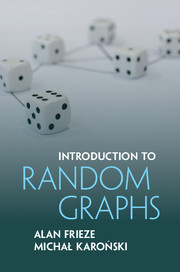Refine listing
Actions for selected content:
1437 results in Ebooks in machine learning
Dedication
-
- Book:
- Mathematical Foundations of Infinite-Dimensional Statistical Models
- Published online:
- 05 December 2015
- Print publication:
- 18 November 2015, pp v-vi
-
- Chapter
- Export citation
Contents
-
- Book:
- Mathematical Foundations of Infinite-Dimensional Statistical Models
- Published online:
- 05 December 2015
- Print publication:
- 18 November 2015, pp vii-x
-
- Chapter
- Export citation
2 - Gaussian Processes
-
- Book:
- Mathematical Foundations of Infinite-Dimensional Statistical Models
- Published online:
- 05 December 2015
- Print publication:
- 18 November 2015, pp 15-108
-
- Chapter
- Export citation

Introduction to Random Graphs
-
- Published online:
- 05 November 2015
- Print publication:
- 26 October 2015
15 - Mappings
- from PART III - Other models
-
- Book:
- Introduction to Random Graphs
- Published online:
- 05 November 2015
- Print publication:
- 26 October 2015, pp 294-306
-
- Chapter
- Export citation
Contents
-
- Book:
- Introduction to Random Graphs
- Published online:
- 05 November 2015
- Print publication:
- 26 October 2015, pp vii-xii
-
- Chapter
- Export citation
Preface
-
- Book:
- Introduction to Random Graphs
- Published online:
- 05 November 2015
- Print publication:
- 26 October 2015, pp xiii-xviii
-
- Chapter
- Export citation
3 - Vertex Degrees
- from PART I - Basic Models
-
- Book:
- Introduction to Random Graphs
- Published online:
- 05 November 2015
- Print publication:
- 26 October 2015, pp 48-62
-
- Chapter
- Export citation
4 - Connectivity
- from PART I - Basic Models
-
- Book:
- Introduction to Random Graphs
- Published online:
- 05 November 2015
- Print publication:
- 26 October 2015, pp 63-70
-
- Chapter
- Export citation
5 - Small Subgraphs
- from PART I - Basic Models
-
- Book:
- Introduction to Random Graphs
- Published online:
- 05 November 2015
- Print publication:
- 26 October 2015, pp 71-80
-
- Chapter
- Export citation
19 - Brief Notes on Uncovered Topics
- from PART III - Other models
-
- Book:
- Introduction to Random Graphs
- Published online:
- 05 November 2015
- Print publication:
- 26 October 2015, pp 364-374
-
- Chapter
- Export citation
Frontmatter
-
- Book:
- Introduction to Random Graphs
- Published online:
- 05 November 2015
- Print publication:
- 26 October 2015, pp i-iv
-
- Chapter
- Export citation
11 - Intersection Graphs
- from PART II - Basic Model Extensions
-
- Book:
- Introduction to Random Graphs
- Published online:
- 05 November 2015
- Print publication:
- 26 October 2015, pp 202-225
-
- Chapter
- Export citation
Author Index
-
- Book:
- Introduction to Random Graphs
- Published online:
- 05 November 2015
- Print publication:
- 26 October 2015, pp 456-461
-
- Chapter
- Export citation
PART IV - Tools and Methods
-
- Book:
- Introduction to Random Graphs
- Published online:
- 05 November 2015
- Print publication:
- 26 October 2015, pp 375-376
-
- Chapter
- Export citation
7 - Extreme Characteristics
- from PART I - Basic Models
-
- Book:
- Introduction to Random Graphs
- Published online:
- 05 November 2015
- Print publication:
- 26 October 2015, pp 110-137
-
- Chapter
- Export citation
14 - Trees
- from PART III - Other models
-
- Book:
- Introduction to Random Graphs
- Published online:
- 05 November 2015
- Print publication:
- 26 October 2015, pp 263-293
-
- Chapter
- Export citation
17 - Real World Networks
- from PART III - Other models
-
- Book:
- Introduction to Random Graphs
- Published online:
- 05 November 2015
- Print publication:
- 26 October 2015, pp 329-348
-
- Chapter
- Export citation
22 - Differential Equations Method
- from PART IV - Tools and Methods
-
- Book:
- Introduction to Random Graphs
- Published online:
- 05 November 2015
- Print publication:
- 26 October 2015, pp 410-413
-
- Chapter
- Export citation
8 - Extremal Properties
- from PART I - Basic Models
-
- Book:
- Introduction to Random Graphs
- Published online:
- 05 November 2015
- Print publication:
- 26 October 2015, pp 138-146
-
- Chapter
- Export citation
